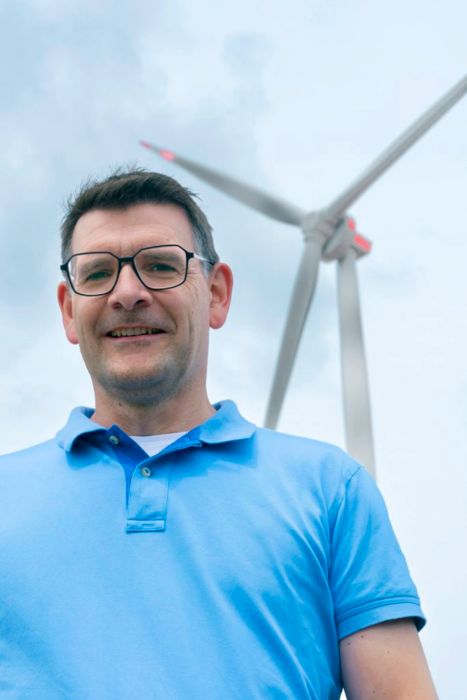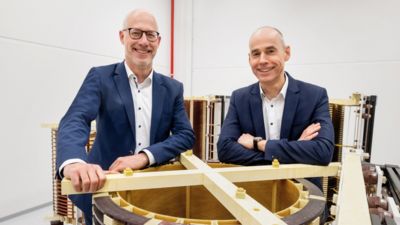Combatting cybercrime with full wind power With effective security solutions, Phoenix Contact protects wind turbine turbines and other renewable energy generators against cybercrime.

Brief summary
When the power supply is attacked, the result does not have to be a complete blackout – even remote wind turbine generators are now networked and therefore become a lucrative target for hackers. At this point, Hauke Kästing, as a member of the Phoenix Contact Service team, sees security as a sparring partner for system manufacturers, investors, and operators of wind turbine generators: Together, we need to take the right paths to protect the wind turbine generator against cybercrime.
With mGuard, Phoenix Contact has a router with an integrated firewall in its program. But technology alone does not provide adequate protection. Phoenix Contact’s services therefore consist primarily of guiding customers with a comprehensive 360° security analysis. And this is where, with existing systems in particular, we need to clarify which upgrade options old systems offer and how the existing automation can be as effective as possible. The whole thing is manufacturer-independent.

Specialist for industrial security: Hauke Kästing
Trillions in losses due to cyberattacks
The global economic losses caused by cybercrime are gigantic – amounting to over a trillion US dollars in 2020 alone, according to the study “The Hidden Costs of Cybercrime” by McAfee, one of the leading companies for online protection. Initially, the hacker business concentrated on classic office IT, but the field of activity is now increasingly expanding to include automation.
The island of happiness no longer exists. Hauke Kästing joins Phoenix Contact in using effective security solutions to protect wind turbine generators and other renewable energy generators against cybercrime. Kästing is therefore among those at Phoenix Contact that is making sustainable actions secure. Secure against criminal attacks. Already as a young boy, Hauke Kästing was pulled to the Hohe Asch in Extertal – the hill that, at 371 meters above mean sea level, is predestined for harvesting wind power. In 1998, the first public wind turbine went into operation here in the Lippe Uplands with a lot of pioneering spirit. With a mast height of 77 m, the system built by Nordex is a dwarf compared to the current machines. The 600 kW of power from back then now stand opposite 3.5 MW systems. Since 2020, two newer Enercon systems have been rotating above Blomberg.
Generating and protecting valuable electricity
Back then, Kästing was simply fascinated by wind power in general, but today the trained radio and television technician concentrates on making wind turbine generators secure. Nowadays, security for renewable power generation can no longer be reduced to localized operational safety. Kästing is a specialist for IT security in the Phoenix Contact Competence Center Services. The increasing networking of plants and connection of entire wind farms by means of communication technology has brought along a new threat: cybercrime.
When the wind blows, energy flows – without coal, gas, or oil. Wind turbine generators are a real gem for the energy revolution – and can also earn real money as well. But this only happens if the windmills are also turning. At the current state of automation technology, the goal is primarily to increase efficiency. This is done, for example, by using electric drives to adjust the blades and nacelles fully automatically. Their task: They hold the windmill head in the wind at an optimal angle or turn it out completely when the wind blows too hard. What would happen if unauthorized persons with plenty of criminal intentions were to change intervention limits in the controller or deactivate automatic shutdowns without being noticed?
With mGuard, we do have a router with an integrated firewall in our program. But technology alone does not provide adequate protection by a long shot.

Wind power and windmills that grind grain – both cases are important for the basic supply of people
From a stand-alone solution to a networked system
“The first wind turbine generators were clear stand-alone solutions and correspondingly resistant to cybercrime”, says Hauke Kästing, looking back. “When something did not work, someone had to drive out”. Today, modern networked systems do not just send error logs, operating data, and alarms. Rather, they also open up the possibility of optimizing operation via remote access. For hackers, the way is now clear for causing damage or even for blackmailing operators by introducing ransomware software by paralyzing the systems. Ransomware is software used to demand ransom money.
At this point, Hauke Kästing, as a member of the Phoenix Contact Service team, sees security as a sparring partner for system manufacturers, investors, and operators. Together, we need to take the right paths to protect the wind turbine generator against cybercrime. “With mGuard, we do have a router with an integrated firewall in our program. But technology alone does not provide adequate protection by a long shot”, says the family man. Phoenix Contact’s services therefore consist primarily of guiding customers with a comprehensive 360° security analysis. And this is where, with existing systems in particular, we need to clarify which upgrade options old systems offer and how the existing automation can be as effective as possible. The whole thing is manufacturer-independent.
Investing in security against cybercrime
For Hauke Kästing, people in the value-added chain are no less important. “What is the use of having the best firewall when service personnel in a hotel, for example, let in a virus when downloading a firmware update and then save the corrupt file directly to the system behind the firewall the next day?”. Anyone who really takes security seriously must also trust and hold their workforce accountable. According to Kästing, hacker attacks are always prepared meticulously and planned well in advance. And with a worrying eye on the war in Ukraine, the aspirations for increased energy autonomy, and the expansion of “renewables”, security is becoming increasingly important. “The interest is growing noticeably and enquiries have increased dramatically since Fall 2021. People are slowly taking this topic seriously. The threat situation is there – as sad as it is”.
It is therefore worth investing in security against cybercrime. For the man from the small village of Eschenbruch in Lippe, Germany, however, there is also a personal passion behind it, which has its roots in his own childhood. The 50-year-old comes from an agricultural family. “My brother took over the business”, he says, drawing a comparison between wind power and windmills that grind grain. “In both cases, we’re talking about basic supplies for people – food or even also electrical energy”.
Connect with our experts

More posts

DC grids for sector coupling
E-mobility, solar systems, and battery storage systems are revolutionizing industry.

Clean water for Lake Constance
Innovative solution for clean water in Lake Constance and efficient pump monitoring.

Energy storage systems connect sectors
The importance of innovative connection technology for the safe operation of energy storage systems and for the realization of the All Electric Society.
